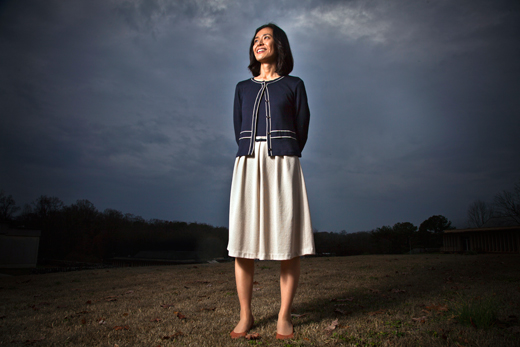Microsoft has awarded Emory University environmental scientist Eri Saikawa an Artificial Intelligence (AI) for Earth grant to help her create an early warning system that would alert the public about dangerous air pollution levels in the Hindu-Kush-Himalayan region of Nepal.
The award is not monetary but provides thousands of dollars’ worth of computational resources, as well as training and support. The computing credits are necessary for Saikawa to sort through massive amounts of emissions and meteorological data, in a bid to better understand the physical mechanisms for the formation of the region’s winter fog.
Leveraging the big data tools is necessary to understand the pollution-laden fog that, trapped by the majestic mountain range, literally blocks the sun and creates environmental and economic hardships for the people and land below.
Saikawa will work on machine learning with collaborators at the International Centre for Integrated Mountain Development and with other researchers at Emory. Those include the Emory College undergraduate students on her team and Alexander Avramov, a researcher in her department who helped build and install air quality sensors around campus to monitor air pollution in Atlanta.
Because the data being collected in Atlanta and Nepal is similar, the new project provides Saikawa and her students the chance to study and propose solutions to improve air quality in regions more than 8,000 miles apart.
“I find it fascinating to learn through data, and I find students are very motivated to have a different way to learn,” says Saikawa, one of Emory’s inaugural Sustainability Faculty Fellows. “Being able to analyze data of this scale gives us an opportunity to amplify our research and help like never before.”
Leveraging AI for a sustainable future
The AI for Earth program is a $50 million, five-year effort that supports the creation of open-source machine learning models and algorithms that directly deliver solutions in climate change, biodiversity conservation, agriculture and water.
The grant includes tutorials and support on using Microsoft Azure, the cloud computing system whose extra server bandwidth is dedicated to the grant winners’ data crunching.
“These environmental challenges have a short time frame for solutions, so we need to leverage AI to have hope for a sustainable future,” says AI for Earth Project Manager Bonnie Lei.
So far, Microsoft has committed to 393 grants in 65 countries. Lei notes that many successful projects involve collaboration between experts in environmental and computer science as well as engaged and eager students, making Saikawa’s project a natural fit for the program.
“We are very excited by what (Saikawa) is doing,” she says. “The more we can encourage an interdisciplinary approach the more likely we are to see innovative solutions.”
Interdisciplinary approach
Saikawa’s research into the sources and magnitudes of emissions linked to air pollution, ozone depletion and global warming is already interdisciplinary, using her training in chemistry, engineering and public affairs.
She has published six papers based on a $157,000 National Science Foundation grant to study the atmospheric chemistry in Nepal and Bhutan. The most recent paper tested the source and impact of air pollution in Nepal’s Kathmandu Valley in particular.
Although she used super computers for that work, Saikawa is excited to see what machine learning can offer. She is now gathering archival data that includes meteorology and air quality in Nepal, which then will be used to assess conditions for winter fog formation.
Combining such information with emissions and air quality modeling results, researchers could see what interventions – for example, curbing brick kiln emissions or cutting back on burning garbage – have the most effect on the fog.
From Atlanta to Nepal
In this project, the team will use data from air quality sensors similar to those her students and research scientists are installing all around campus at Emory. One has been installed atop the Math and Science Center, and three more are ready to be deployed this fall.
Students can get involved by taking classes with Saikawa or joining her research team, made up of undergraduates whose majors range from environmental science and biology to quantitative science and computer science.
“There are a lot of perspectives to consider with environmental issues,” says Anna Munslow, a computer science major who is collecting and visualizing data pulled from the campus sensor this summer. Similar work may eventually be done on the AI project.
Munslow is doing the work remotely and after-hours from her software engineering internship with Aerospace Corporation in California.
A rising senior in Emory’s 4+1 program, which will allow her to earn a master’s degree in computer science next year, Munslow is especially interested in exploring machine learning to pursue environmental solutions.
“We want to be able to inform community members about any issue with their air quality, no matter where they are,” she says.

